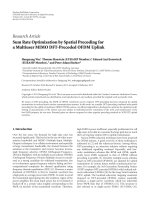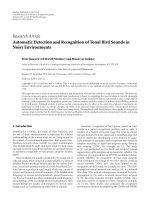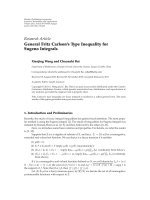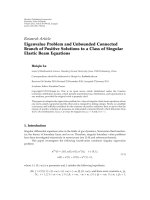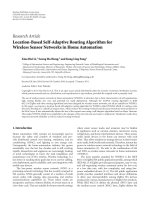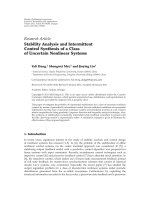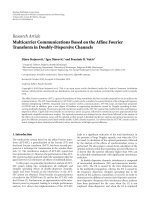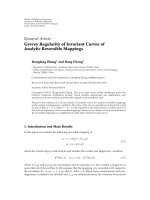báo cáo hóa học:" Research Article Local Regularity and Local Boundedness Results for Very Weak Solutions of Obstacle Problems" pot
Bạn đang xem bản rút gọn của tài liệu. Xem và tải ngay bản đầy đủ của tài liệu tại đây (500.33 KB, 12 trang )
Hindawi Publishing Corporation
Journal of Inequalities and Applications
Volume 2010, Article ID 878769, 12 pages
doi:10.1155/2010/878769
Research Article
Local Regularity and Local Boundedness Results
for Very Weak Solutions of Obstacle Problems
Gao Hongya,
1, 2
Qiao Jinjing,
3
and Chu Yuming
4
1
College of Mathematics and Computer Science, Hebei University, Baoding 071002, China
2
Hebei Provincial Center of Mathematics, Hebei Normal University, Shijiazhuang 050016, China
3
College of Mathematics and Computer Science, Hunan Normal University, Changsha 410081, China
4
Faculty of Science, Huzhou Teachers College, Huzhou, Zhejiang 313000, China
Correspondence should be addressed to Gao Hongya,
Received 25 September 2009; Accepted 18 March 2010
Academic Editor: Yuming Xing
Copyright q 2010 Gao Hongya et al. This is an open access article distributed under the Creative
Commons Attribution License, which permits unrestricted use, distribution, and reproduction in
any medium, provided the original work is properly cited.
Local regularity and local boundedness results for very weak solutions of obstacle problems
of the A-harmonic equation divAx, ∇ux 0 are obtained by using the theory of Hodge
decomposition, where |Ax, ξ|≈|ξ|
p−1
.
1. Introduction and Statement of Results
Let Ω be a bounded regular domain in R
n
, n ≥ 2. By a regular domain we understand
any domain of finite measure for which the estimates for the Hodge decomposition in 1.5
and 1.6 are satisfied; see 1. A Lipschitz domain, for example, is a regular domain. We
consider the second-order divergence type elliptic equation also called A-harmonic equation
or Leray-Lions equation:
div A
x, ∇u
x
0, 1.1
where Ax, ξ : Ω × R
n
→ R
n
is a Carath
´
eodory function satisfying the following conditions:
a Ax, ξ,ξ≥α|ξ|
p
,
b |Ax, ξ|≤β|ξ|
p−1
,
c Ax, 00,
2 Journal of Inequalities and Applications
where p>1and0<α≤ β<∞. The prototype of 1.1 is the p-harmonic equation:
div
|
∇u
|
p−2
∇u
0. 1.2
Suppose that ψ is an arbitrary function in Ω with values in R ∪{±∞},andθ ∈ W
1,r
Ω with
max{1,p− 1} <r≤ p.Let
K
r
ψ,θ
Ω
v ∈ W
1,r
Ω
: v ≥ ψ a.e., and v − θ ∈ W
1,r
0
Ω
. 1.3
The function ψ is an obstacle and θ determines the boundary values.
For any u, v ∈K
r
ψ,θ
Ω, we introduce the Hodge decomposition for |∇v − u|
r−p
∇v −
u ∈ L
r/r−p1
Ω,see1:
|
∇
v − u
|
r−p
∇
v − u
∇φ
v,u
h
v,u
, 1.4
where φ
v,u
∈ W
1,r/r−p1
0
Ω and h
v,u
∈ L
r/r−p1
Ω, R
n
are a divergence-free vector field,
and the following estimates hold:
∇φ
v,u
r/r−p1
≤ c
1
∇
v − u
r−p1
r
,
1.5
h
v,u
r/r−p1
≤ c
1
p − r
∇
v − u
r−p1
r
,
1.6
where c
1
c
1
n, p is some constant depending only on n and p.
Definition 1.1 see 2. A very weak solution to the K
r
ψ,θ
-obstacle problem is a function u ∈
K
r
ψ,θ
Ω such that
Ω
A
x, ∇u
,
|
∇
v − u
|
r−p
∇
v − u
dx ≥
Ω
A
x, ∇u
,h
v,u
dx,
1.7
whenever v ∈K
r
ψ,θ
Ω.
Remark 1.2. If r p in Definition 1.1, then h
v,u
0 by the uniqueness of the Hodge
decomposition 1.4,and1.7 becomes
Ω
A
x, ∇u
, ∇
v − u
dx ≥ 0.
1.8
This is the classical definition for K
p
ψ,θ
-obstacle problem; see 3 for some details of solutions
of K
p
ψ,θ
-obstacle problem.
Journal of Inequalities and Applications 3
This paper deals with local regularity and local boundedness for very weak solutions
of obstacle problems. Local regularity and local boundedness properties are important
among the regularity theories of nonlinear elliptic systems; see the recent monograph 4
by Bensoussan and Frehse. Meyers and Elcrat 5 first considered the higher integrability for
weak solutions of 1.1 in 1975; see also 6. Iwaniec and Sbordone 1 obtained the regularity
result for very weak solutions of the A-harmonic 1.1 by using the celebrated Gehring’s
Lemma. The local and global higher integrability of the derivatives in obstacle problem was
first considered by Li and Martio 7 in 1994 by using the so-called reverse H
¨
older inequality.
Gao et al. 2 gave the definition for very weak solutions of obstacle problem of A-harmonic
1.1 and obtained the local and global higher integrability results. The local regularity results
for minima of functionals and solutions of elliptic equations have been obtained in 8. For
some new results related to A-harmonic equation, we refer the reader to 9–11. Gao and
Tian 12 gave the local regularity result for weak solutions of obstacle problem with the
obstacle function ψ ≥ 0. Li and Gao 13 generalized the result of 12 by obtaining the local
integrability result for very weak solutions of obstacle problem. The main result of 13 is the
following proposition.
Proposition 1.3. There exists r
1
with max{1,p− 1} <r
1
<p, such that any very weak solution u to
the K
r
ψ,θ
-obstacle problem belongs to L
s
∗
loc
Ω, s
∗
1/1/s − 1/n, provided that 0 ≤ ψ ∈ W
1,s
loc
Ω,
r<s<n, and r
1
<r<min{p, n}.
Notice that in the above proposition we have restricted ourselves to the case r<n,
because when r ≥ n, every function in W
1,r
loc
Ω is trivially in L
t
loc
Ω for every t>1bythe
classical Sobolev imbedding theorem.
In the first part of this paper, we continue to consider the local regularity theory
for very weak solutions of obstacle problem by showing that the condition ψ ≥ 0in
Proposition 1.3 is not necessary.
Theorem 1.4. There exists r
1
with max{1,p − 1} <r
1
<p, such that any very weak solution
u to the K
r
ψ,θ
-obstacle problem belongs to L
s
∗
loc
Ω, provided that ψ ∈ W
1,s
loc
Ω, r<s<n, and
r
1
<r<min{p, n}.
As a corollary of the above theorem, if r p, that is, if we consider weak solutions of
K
p
ψ,θ
-obstacle problem, then we have the following local regularity result.
Corollary 1.5. Suppose that ψ ∈ W
1,s
loc
Ω, 1 <p<s<n. Then a solution u to the K
p
ψ,θ
-obstacle
problem belongs to L
s
∗
loc
Ω.
We omit the proof of this corollary. This corollary shows that the condition ψ ≥ 0inthe
main result of 12 is not necessary.
The second part of this paper considers local boundedness for very weak solutions
of K
r
ψ,θ
-obstacle problem. The local boundedness for solutions of obstacle problems plays
a central role in many aspects. Based on the local boundedness, we can further study the
regularity of the solutions. For the local boundedness results of weak solutions of nonlinear
elliptic equations, we refer the reader to 4. In this paper we consider very weak solutions
and show that if the obstacle function is ψ ∈ W
1,∞
loc
Ω, then a very weak solution u to the
K
r
ψ,θ
-obstacle problem is locally bounded.
4 Journal of Inequalities and Applications
Theorem 1.6. There exists r
1
with max{1,p − 1} <r
1
<p, such that for any r with r
1
<r<
min{p, n} and any ψ ∈ W
1,∞
loc
Ω, a very weak solution u to the K
r
ψ,θ
-obstacle problem is locally
bounded.
Remark 1.7. As far as we are aware, Theorem 1.6 is the first result concerning local
boundedness for very weak solutions of obstacle problems.
In the remaining part of this section, we give some symbols and preliminary lemmas
used in the proof of the main results. If x
0
∈ Ω and t>0, then B
t
denotes the ball of radius
t centered at x
0
. For a function ux and k>0, let A
k
{x ∈ Ω : |ux| >k}, A
k
{x ∈ Ω :
ux >k}, A
k,t
A
k
∩ B
t
, A
k,t
A
k
∩ B
t
. Moreover if s<n, s
∗
is always the real number
satisfying 1/s
∗
1/s − 1/n.LetT
k
u be the usual truncation of u at level k>0, that is,
T
k
u
max
{
−k, min
{
k, u
}}
. 1.9
Let t
k
umin{u, k}.
We recall two lammas which will be used in the proof of Theorem 1.4.
Lemma 1.8 see 8. Let u ∈ W
1,r
loc
Ω, ϕ
0
∈ L
q
loc
Ω,where1 <r<nand q satisfies
1 <q<
n
r
.
1.10
Assume that the following integral estimate holds:
A
k,t
|
∇u
|
r
dx ≤ c
0
A
k,t
ϕ
0
dx
t − τ
−α
A
k,t
|
u
|
r
dx
, 1.11
for every k ∈ N and R
0
≤ τ<t≤ R
1
,wherec
0
is a real positive constant that depends only on
N, q, r, R
0
,R
1
, |Ω| and α is a real positive constant. Then u ∈ L
qr
∗
loc
Ω.
Lemma 1.9 see 14. Let fτ be a nonnegative bounded function defined for 0 ≤ R
0
≤ t ≤ R
1
.
Suppose that for R
0
≤ τ<t≤ R
1
one has
f
τ
≤ A
t − τ
−α
B θf
t
, 1.12
where A, B, α, θ are nonnegative constants and θ<1. Then there exists a constant c
2
c
2
α, θ,
depending only on α and θ, such that for every ρ, R, R
0
≤ ρ<R≤ R
1
one has
f
ρ
≤ c
2
A
R − ρ
−α
B
. 1.13
We need the following definition.
Journal of Inequalities and Applications 5
Definition 1.10 see 15.Afunctionux ∈ W
1,m
loc
Ω belongs to the class BΩ,γ,m,k
0
, if for
all k>k
0
, k
0
> 0andallB
ρ
B
ρ
x
0
, B
ρ−ρσ
B
ρ−ρσ
x
0
, B
R
B
R
x
0
, one has
A
k,ρ−ρσ
|
∇u
|
m
dx ≤ γ
σ
−m
ρ
−m
A
k,ρ
u − k
m
dx
A
k,ρ
,
1.14
for R/2 ≤ ρ − ρσ<ρ<R, m<n, where |A
k,ρ
| is the n-dimensional Lebesgue measure of the
set A
k,ρ
.
We recall a lemma from 15 which will be used in the proof of Theorem 1.6.
Lemma 1.11 see 15. Suppose that ux is an arbitrary function belonging to the class
BΩ,γ,m,k
0
and B
R
⊂⊂ Ω. Then one has
max
B
R/2
u
x
≤ c,
1.15
in which the constant c is determined only by the quantities γ,m,k
0
,R,∇u
m
1
.
2. Local Regularity
Proof of Theorem 1.4. Let u be a very weak solution to the K
r
ψ,θ
-obstacle problem. By
Lemma 1.8,itissufficient to prove that u satisfies the inequality 1.11 with α r.Let
B
R
1
⊂⊂ Ω and 0 <R
0
≤ τ<t≤ R
1
be arbitrarily fixed. Fix a cut-off function φ ∈ C
∞
0
B
R
1
such
that
supp φ ⊂ B
t
, 0 ≤ φ ≤ 1,φ 1inB
τ
,
∇φ
≤ 2
t − τ
−1
.
2.1
Consider the function
v u − T
k
u
− φ
r
u − ψ
k
, 2.2
where T
k
u is the usual truncation of u at level k ≥ 0 defined in 1.9 and ψ
k
max{ψ, T
k
u}.
Now v ∈K
r
ψ−T
k
u,θ−T
k
u
Ω; indeed, since u ∈K
r
ψ,θ
Ω and φ ∈ C
∞
0
Ω, then
v −
θ − T
k
u
u − θ − φ
r
u − ψ
k
∈ W
1,r
0
Ω
,
v −
ψ − T
k
u
u − ψ − φ
r
u − ψ
k
≥
1 − φ
r
u − ψ
≥ 0,
2.3
6 Journal of Inequalities and Applications
a.e. in Ω.Let
E
v, u
φ
r
∇u
r−p
φ
r
∇u
|
∇
v − u T
k
u
|
r−p
∇
v − u T
k
u
,
2.4
By an elementary inequality 16, Page 271, 4.1,
|
X
|
−ε
X −
|
Y
|
−ε
Y
≤ 2
ε
1 ε
1 − ε
|
X − Y
|
1−ε
,X,Y∈ R
n
, 0 ≤ ε<1,
∇v ∇
u − T
k
u
− φ
r
∇
u − ψ
k
− rφ
r−1
∇φ
u − ψ
k
,
2.5
one can derive that
|
E
v, u
|
≤ 2
p−r
p − r 1
r − p 1
φ
r
∇ψ
k
− rφ
r−1
∇φ
u − ψ
k
r−p1
.
2.6
We get from the definition of Ev, u that
A
k,t
A
x, ∇u
,
φ
r
∇u
r−p
φ
r
∇u
dx
A
k,t
A
x, ∇u
,E
v, u
dx
−
A
k,t
A
x, ∇u
,
|
∇
v − u T
k
u
|
r−p
∇
v − u T
k
u
dx
A
k,t
A
x, ∇u
,E
v, u
dx
−
A
k,t
A
x, ∇u
,
|
∇
v − u
|
r−p
∇
v − u
dx.
2.7
Now we estimate the left-hand side of 2.7. By condition a we have
A
k,t
A
x, ∇u
,
φ
r
∇u
r−p
φ
r
∇ud ≥
A
k,τ
A
x, ∇u
,
|
∇u
|
r−p
∇udx ≥ α
A
k,τ
|
∇u
|
r
dx.
2.8
Since u − T
k
u,v ∈K
r
ψ−T
k
u,θ−T
k
u
Ω, then using the Hodge decomposition 1.4,weget
|
∇
v − u T
k
u
|
r−p
∇
v − u T
k
u
∇φ h, 2.9
and by 1.6 we have
h
r/r−p1
≤ c
1
p − r
∇v − u T
k
u
r−p1
r
.
2.10
Journal of Inequalities and Applications 7
Thus we derive, by Definition 1.1,that
Ω
A
x, ∇
u − T
k
u
,
|
∇
v − u T
k
u
|
r−p
∇
v − u T
k
u
dx
≥
Ω
A
x, ∇
u − T
k
u
,h
dx.
2.11
This means, by condition c,that
A
k,t
A
x, ∇u
,
|
∇
v − u
|
r−p
∇
v − u
dx ≥
A
k,t
A
x, ∇u
,h
dx. 2.12
Combining the inequalities 2.7, 2.8,and2.12,andusingH
¨
older’s inequality and
condition b,weobtain
α
A
k,τ
|
∇u
|
r
dx ≤
A
k,t
A
x, ∇u
,E
v, u
dx −
A
k,t
A
x, ∇u
,h
dx
≤ β
2
p−r
p − r 1
r − p 1
A
k,t
|
∇u
|
p−1
φ
r
∇ψ
k
− rφ
r−1
∇φ
u − ψ
k
r−p1
dx
β
A
k,t
|
∇u
|
p−1
|
h
|
dx
≤ β
2
p−r
p − r 1
r − p 1
A
k,t
|
∇u
|
p−1
φ
r
∇ψ
k
r−p1
dx
β
2
p−r
p − r 1
r − p 1
A
k,t
|
∇u
|
p−1
rφ
r−1
∇φ
u − ψ
k
r−p1
dx
β
A
k,t
|
∇u
|
p−1
|
h
|
dx
≤ β
2
p−r
p − r 1
r − p 1
A
k,t
|
∇u
|
r
dx
p−1/r
A
k,t
∇ψ
k
r
dx
r−p1/r
β
2
p−r
p − r 1
r − p 1
A
k,t
|
∇u
|
r
dx
p−1/r
×
A
k,t
rφ
r−1
∇φ
u − ψ
k
r
dx
r−p1/r
β
A
k,t
|
∇u
|
r
dx
p−1/r
A
k,t
|
h
|
r/r−p1
dx
r−p1/r
.
2.13
8 Journal of Inequalities and Applications
Denote c
3
c
3
p, r2
p−r
p − r 1/r − p 1. It is obvious that if r is sufficiently close to p,
then c
3
p, r ≤ 2. By 2.10 and Young’s inequality
ab ≤ εa
p
c
4
ε, p
b
p
,
1
p
1
p
1,a,b≥ 0,ε≥ 0,p≥ 1,
2.14
we can derive that
α
A
k,τ
|
∇u
|
r
dx ≤ βc
3
p, r
ε
A
k,t
|
∇u
|
r
dx βc
3
p, r
c
4
ε, p
A
k,t
∇ψ
k
r
dx
βc
3
p, r
ε
A
k,t
|
∇u
|
r
dx βc
3
p, r
c
4
ε, p
A
k,t
rφ
r−1
∇φ
u − ψ
k
r
dx
βc
1
ε
p − r
A
k,t
|
∇u
|
r
dx βc
1
c
4
ε, p
p − r
Ω
|
∇
v − u T
k
u
|
r
dx
≤ βε
2c
3
p, r
c
1
p − r
A
k,t
|
∇u
|
r
dx βc
3
p, r
c
4
ε, p
A
k,t
∇ψ
k
r
dx
βc
3
p, r
c
4
ε, p
A
k,t
rφ
r−1
∇φ
u − ψ
k
r
dx
βc
1
c
4
ε, p
p − r
Ω
|
∇
v − u T
k
u
|
r
dx.
2.15
By the equality
∇v ∇
u − T
k
u
− φ
r
∇
u − ψ
k
− rφ
r−1
∇φ
u − ψ
k
,
2.16
and v − u T
k
u0forx ∈ Ω \ A
k,t
, then we have
Ω
|
∇
v − u T
k
u
|
r
dx
A
k,t
φ
r
∇
u − ψ
k
rφ
r−1
∇φ
u − ψ
k
r
dx
≤ 2
r−1
A
k,t
|
∇u
|
r
dx
A
k,t
∇ψ
k
r
dx
A
k,t
rφ
r−1
∇φ
u − ψ
k
r
dx
.
2.17
Journal of Inequalities and Applications 9
Finally we obtain that
A
k,τ
|
∇u
|
r
dx ≤
βε
2c
3
p, r
c
1
p − r
2
r−1
βc
1
c
4
ε, p
p − r
α
A
k,t
|
∇u
|
r
dx
βc
3
p, r
c
4
ε, p
2
r−1
βc
1
c
4
ε, p
p − r
α
A
k,t
∇ψ
k
r
dx
βc
3
p, r
c
4
ε, p
2
r−1
βc
1
c
4
ε, p
p − r
α
A
k,t
rφ
r−1
∇φ
u − ψ
k
r
dx
≤
βε
2c
3
p, r
c
1
p − r
2
p−1
βc
1
c
4
ε, p
p − r
α
A
k,t
|
∇u
|
r
dx
βc
3
p, r
c
4
ε, p
2
p−1
βc
1
c
4
ε, p
p − r
α
A
k,t
∇ψ
r
dx
βc
3
p, r
c
4
ε, p
2
p−1
βc
1
c
4
ε, p
p − r
α
2
p
p
t − τ
r
A
k,t
|
u
|
r
dx.
2.18
The last i nequality holds since |u − ψ
k
|≤|u| a.e. in A
k,t
. Now we want to eliminate the first
term in the right-hand side containing ∇u. Choose ε small enough and r sufficiently close to
p such that
θ
βε
2c
3
p, r
c
1
p − r
2
p−1
βc
1
c
4
ε, p
p − r
α
< 1,
2.19
and let ρ,R be arbitrarily fixed with R
0
≤ ρ<R≤ R
1
.Thus,from2.18, we deduce that for
every τ and t such that ρ ≤ τ<t≤ R, we have
A
k,τ
|
∇u
|
r
dx ≤ θ
A
k,t
|
∇u
|
r
dx
c
5
α
A
k,R
∇ψ
r
dx
c
6
α
t − τ
r
A
k,R
|
u
|
r
dx,
2.20
where c
5
βc
3
p, rc
4
ε, p2
p−1
βc
1
c
4
ε, pp − r with ε and r fixed to satisfy 2.19,and
c
6
2
p
pc
5
. Applying Lemma 1.9 in 2.20 we conclude that
A
k,ρ
|
∇u
|
r
dx ≤
c
2
c
5
α
A
k,R
∇ψ
r
dx
c
2
c
6
α
R − ρ
r
A
k,R
|
u
|
r
dx,
2.21
where c
2
is the constant given by Lemma 1.9.Thusu satisfies inequality 1.11 with ϕ
0
|∇ψ|
r
and α r. Theorem 1.4 follows from Lemma 1.8.
10 Journal of Inequalities and Applications
3. Local Boundedness
Proof of Theorem 1.6. Let u be a very weak solution to the K
r
ψ,θ
-obstacle problem. Let B
R
1
⊂⊂ Ω
and R
1
/2 ≤ τ<t≤ R
1
be arbitrarily fixed. Fix a cut-off function φ ∈ C
∞
0
B
R
1
such that
supp φ ⊂ B
t
, 0 ≤ φ ≤ 1,φ 1inB
τ
,
∇φ
≤ 2
t − τ
−1
.
3.1
Consider the function
v u − t
k
u
− φ
r
u − max
ψ, t
k
u
, 3.2
where t
k
umin{u, k}.Nowv ∈K
r
ψ−t
k
u,θ−t
k
u
; indeed, since u ∈K
r
ψ,θ
Ω and φ ∈ C
∞
0
Ω,
then
v −
θ − t
k
u
u − θ − φ
r
u − max
ψ, t
k
u
∈ W
1,r
0
Ω
,
v −
ψ − t
k
u
u − ψ − φ
r
u − max
ψ, t
k
u
≥
1 − φ
r
u − ψ
≥ 0
3.3
a.e. in Ω.
As in the proof of Theorem 1.4,weobtain
A
k,τ
|
∇u
|
r
dx ≤
βε
2c
3
p, r
c
1
p − r
2
r−1
βc
1
c
4
ε, p
p − r
α
A
k,t
|
∇u
|
r
dx
βc
3
c
4
ε, p
2
r−1
βc
1
c
4
ε, p
p − r
α
A
k,t
∇ max
ψ, t
k
u
r
dx
βc
3
p, r
c
4
ε, p
2
r−1
βc
1
c
4
ε, p
p − r
α
×
A
k,t
rφ
r−1
∇φu − max{ψ, t
k
u}
r
dx
≤
βε
2c
3
p, r
c
1
p − r
2
r−1
βc
1
c
4
ε, p
p − r
α
A
k,t
|
∇u
|
r
dx
βc
3
c
4
ε, p
2
r−1
βc
1
c
4
ε, p
p − r
α
A
k,t
∇ψ
r
dx
βc
3
p, r
c
4
ε, p
2
r−1
βc
1
c
4
ε, p
p − r
α
2
p
p
t − τ
r
A
k,t
|
u − k
|
r
dx.
3.4
Choose ε small enough and r
1
sufficiently close to p such that 2.19 holds. Let ρ, R be
arbitrarily fixed with R
1
/2 ≤ ρ<R≤ R
1
.Thusfrom3.4 we deduce that for every τ and
t such that R
1
/2 ≤ τ<t≤ R
1
, we have
A
k,τ
|
∇u
|
r
dx ≤ θ
A
k,t
|
∇u
|
r
dx
c
5
α
A
k,R
∇ψ
r
dx
c
6
α
t − τ
r
A
k,R
|
u − k
|
r
dx.
3.5
Journal of Inequalities and Applications 11
Applying Lemma 1.9, we conclude that
A
k,ρ
|
∇u
|
r
dx ≤
c
2
c
6
α
R − ρ
r
A
k,R
|
u − k
|
r
dx
c
2
c
5
α
A
k,R
∇ψ
r
dx
≤
c
2
c
6
α
R − ρ
r
A
k,R
|
u − k
|
r
dx
c
2
c
5
c
7
α
A
k,R
,
3.6
where c
2
is the constant given by Lemma 1.9 and c
7
∇ψ
p
L
∞
Ω
.Thusu belongs to the class
B with γ max{c
2
c
6
/α, c
2
c
5
c
7
/α} and m r. Lemma 1.11 yields
max
B
R/2
u
x
≤ c.
3.7
This result together with the assumptions u ≥ ψ and ψ ∈ W
1,∞
loc
Ω yields the desired result.
Acknowledgments
The authors would like to thank the referee of this paper for helpful comments upon which
this paper was revised. The first author is supported by NSFC 10971224 and NSF of Hebei
Province 07M003. The third author is supported by NSF of Zhejiang province Y607128
and NSFC 10771195.
References
1 T. Iwaniec and C. Sbordone, “Weak minima of variational integrals,” Journal f
¨
ur die reine und
angewandte Mathematik, vol. 454, pp. 143–161, 1994.
2 H. Y. Gao, M. Wang, and H. L. Zhao, “Very weak solutions for obstacle problems of the A-harmonic
equation,” Journal of Mathematical Research and Exposition, vol. 24, no. 1, pp. 159–167, 2004 Chinese.
3 J. Heinonen, T. Kilpel
¨
ainen, and O. Martio, Nonlinear Potential Theory of Degenerate Elliptic Equations,
Oxford Mathematical Monographs, The Clarendon Press, Oxford, UK, 1993.
4 A. Bensoussan and J. Frehse, Regularity Results for Nonlinear Elliptic Systems and Applications, vol. 151
of Applied Mathematical Sciences, Springer, Berlin, Germany, 2002.
5 N. G. Meyers and A. Elcrat, “Some results on regularity for solutions of non-linear elliptic systems
and quasi-regular functions,” Duke Mathematical Journal, vol. 42, pp. 121–136, 1975.
6 E. W. Strdulinsky, “Higher integrability from reverse H
¨
older inequalities,” Indiana University
Mathematics Journal, vol. 29, pp. 408–413, 1980.
7 G. B. Li and O. Martio, “Local and global integrability of gradients in obstacle problems,” Annales
Academiae Scientiarum Fennicae. Series A, vol. 19, no. 1, pp. 25–34, 1994.
8 D. Giachetti and M. M. Porzio, “Local regularity results for minima of functionals of the calculus of
variation,” Nonlinear Analysis: Theory, Methods & Applications, vol. 39, no. 4, pp. 463–482, 2000.
9 Y. Xing and S. Ding, “Inequalities for Green’s operator with Lipschitz and BMO norms,” Computers &
Mathematics with Applications, vol. 58, no. 2, pp. 273–280, 2009.
10 S. Ding, “Lipschitz and BMO norm inequalities for operators,” Nonlinear Analysis: Theory, Methods &
Applications, vol. 71, no. 12, pp. e2350–e2357, 2009.
11 H. Gao, J. Qiao, Y. Wang, and Y. Chu, “Local regularity results for minima of anisotropic functionals
and solutions of anisotropic equations,” Journal of Inequalities and Applications, vol. 2008, Article ID
835736, 11 pages, 2008.
12 Journal of Inequalities and Applications
12 H. Gao and H. Tian, “Local regularity result for solutions of obstacle problems,” Acta Mathematica
Scientia B, vol. 24, no. 1, pp. 71–74, 2004.
13 J. Li and H. Gao, “Local regularity result for very weak solutions of obstacle problems,” Radovi
Matemati
ˇ
cki, vol. 12, no. 1, pp. 19–26, 2003.
14 M. Giaquinta, Multiple Integrals in the Calculus of Variations and Nonlinear Elliptic Systems, vol. 105 of
Annals of Mathematics Studies, Princeton University Press, Princeton, NJ, USA, 1983.
15 M. C. Hong, “Some remarks on the minimizers of variational integrals with nonstandard growth
conditions,” Bollettino dell’Unione Matematica Italiana, vol. 6, no. 1, pp. 91–101, 1992.
16 T. Iwaniec, L. Migliaccio, L. Nania, and C. Sbordone, “Integrability and removability results for
quasiregular mappings in high dimensions,” Mathematica Scandinavica, vol. 75, no. 2, pp. 263–279,
1994.


